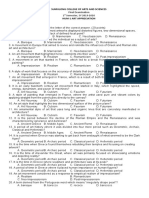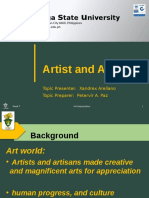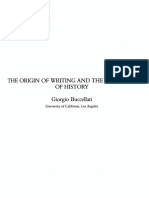Art App Exam
Art App Exam
Uploaded by
maria pancipaniCopyright:
Available Formats
Art App Exam
Art App Exam
Uploaded by
maria pancipaniOriginal Description:
Original Title
Copyright
Available Formats
Share this document
Did you find this document useful?
Is this content inappropriate?
Copyright:
Available Formats
Art App Exam
Art App Exam
Uploaded by
maria pancipaniCopyright:
Available Formats
MIDTERM EXAM
Name: Ma. Cecilia P. Pancipani
Course Year & Section: BSBA MARKETING MANAGEMENT – 1CMT1I
Score: __________
I. DIRECTION: True or False: Write “T” for true or “F” for false for each statement.1pts each
F 1. In the painting “The Garden of Earthly Delights,” Bosch creates a world where
humans live exemplary Christian lives.
F 2. In the mid 18thcentury craft such as pottery and textiles were merged with
Painting and sculpture in the term Fine Art.
F 3. A gridded sketch is used to enlarge smaller drawings into larger works.
T 4. Cross hatching is crisscrossing lines (parallel, perpendicular and diagonal).
T 5. Non-Representational Artis art that attempts to offer no information that relates
to objects we would naturally encounter in life.
F 6. The Pietà is a subject in Christian art depicting Jesus Christ on the Cross
F 7. Diagonal lines almost always imply in action.
F 8. Complementary harmonies involve colors are very close or next to one another
on the color wheel.
F 9. Charcoal pencils are made with compressed graphite.
F 10. When you mix a red light, a blue light and a yellow or yellow green light, you
get black.
F 11. Art, since Marcel Duchamp, has been more about rendering (how well it is
made) than the concept or idea.
F 12. A bodhisattva is just the same as a Buddha
II. Multiple Choice
DIRECTION: Choose the correct answer
Part 1
1. Many of our ancestors erected statues for the divine they worshiped.
A. Physical
B. Social
C. Religious
D. Personal
.
2. Sculptures serve as columns of some buildings as in Greek and Roman architecture.
A. Physical
B. Historical
C. Personal
D. Aesthetic
3. Some people compose songs or write poems in order to convey their innermost
emotions and feelings towards their beloved.
A. Historical
B. Personal
C. Physical
4. Political art may convey message of protest, contestation or whatever message the
artists intend to carry.
A. Religious
B. Social
c. Physical
D. Personal
5. Paintings, sculpture and theater design are sights to behold. Moreover, these visual
arts embellish some forms of architecture.
A. Historical
B. Aesthetic
C. Personal
E. Physical
6. Some people compose songs or write poems in order to convey theirinnermost
emotions and feelings towards their beloved.
A. Religious
B. Physical
C. Personal
D. Historical
7. A Japanese raku bowl that is used in a tea ceremony functions as _______.
A. Religious
B. Physical
C. Historical
D. Personal
8. Art is made by people who employs their skill, ingenuity or creativity.
A. Art involves Experience
B. Art is Universal
C. art is not nature
9. Art knows no boundaries. It has risen above cultures, races, and civilizations.
A. Art is not nature
B. Art is universal
C. Art involves experiences
10. Art requires immersion in the arts; people can appreciate arts if they actually look
into it, listen to it, touch it, feel it, and create it.
A. Art is not nature
B. Art involves experience
C. Art is universal
Part 2 Chose the right meaning or best description
11. Abstraction
A non-representational artwork that has meaning only within itself
A simplification of a natural setting
A representational artwork that is stylized in some way
An analysis of an intricate design
12. Lintel
A triangular bracket of brick or stone
An object that perceived to be the embodiment of a holy spirit
An architectural movement that came about during the early 20th century;
emphasized volume over form and avoided ornamentation
A horizontal beam spanning above an entry way
13. Apotrope
An object thought to have the power to repel evil
Woolen tunic worn by people of ancient Greece
Avenue or entrance way to a building
Bronze pottery used to mix wine and water
A small circular building of sacred use
14. Contrapposto
Great father of the nation
A devoted religious organization group formed by the laymen during the Middle
Ages
A Christian-based militaristic campaign during the 11th - 13th centuries
"counterpoise"; appearance of weight being shifted in the sculpture to imply
movement
15. Sfumato
Aboriginal cape
A painting technique used to create soft modeling; described as "smokey"
The truthfulness of a subject matter
"holy" measuring tape
III. ENUMERATION
1-7 Function of the Arts
Art for Delight.
Art as Commentary.
Art in Worship.
Art in Ritual.
Art for Commemoration.
Art for Persuasion.
Art as Self-Expression.
8-10 Elements of the Arts
Imagination
Creativity
Expression
11-15 Sample of Visual Arts
painting
drawing
printmaking
sculpture
ceramics
16-20 Sample of Non-Visual Arts
Music.
Literature.
Spoken word
Dance
Theater
Send your answer: at rhl_taz2005@yahoo.com
You might also like
- Atelier5 Siedlung HalenDocument9 pagesAtelier5 Siedlung HalenqwertzuiopoooNo ratings yet
- Syllabus-GE 6 Art AppreciationDocument23 pagesSyllabus-GE 6 Art AppreciationVeligen Berueda100% (1)
- Liu Cixin - Ball LightningDocument22 pagesLiu Cixin - Ball LightningLi Qi100% (2)
- Dianne de Las Casas - Kamishibai Story TheaterDocument99 pagesDianne de Las Casas - Kamishibai Story TheaterИв-Кристиан АнгеловNo ratings yet
- Photojournalism: Prepared By: Jim Gary O. VillenaDocument30 pagesPhotojournalism: Prepared By: Jim Gary O. Villenasoulmate06302013100% (1)
- READING VISUAL ARTS (Prelim)Document4 pagesREADING VISUAL ARTS (Prelim)arabelarazal0605No ratings yet
- Lesson 4-Subject and ContentDocument35 pagesLesson 4-Subject and ContentKi KoNo ratings yet
- Art AppreciationDocument10 pagesArt AppreciationMaureen Joy BautistaNo ratings yet
- Art AppreciationDocument6 pagesArt AppreciationJam KaiiNo ratings yet
- Earning Outcomes: LSPU Self-Paced Learning Module (SLM)Document27 pagesEarning Outcomes: LSPU Self-Paced Learning Module (SLM)Joanne Cristie Tolopia100% (1)
- Art Appreciation Midterm ActivityDocument10 pagesArt Appreciation Midterm ActivityLaarnie Garcia Torreon IINo ratings yet
- Art AppDocument67 pagesArt AppNicholas TagleNo ratings yet
- Arts App. Soul MakingDocument13 pagesArts App. Soul MakingJonathan LorenzoNo ratings yet
- Art Appreciation Module 5Document3 pagesArt Appreciation Module 5Michael Anthony EnajeNo ratings yet
- Art Appreciation Module - Lesson 12345Document8 pagesArt Appreciation Module - Lesson 12345arianeNo ratings yet
- Lesson 4 Subject An ContentDocument21 pagesLesson 4 Subject An Contentmarvin quitaNo ratings yet
- Mediums of The Visual ArtsDocument31 pagesMediums of The Visual ArtsJojo AcuñaNo ratings yet
- Lesson 1 Art AppreciationDocument65 pagesLesson 1 Art AppreciationBenjie Rodriguez Panlican100% (3)
- Art Appreciation Module 1Document12 pagesArt Appreciation Module 1Hazel NantesNo ratings yet
- A Course Module In: Art AppreciationDocument23 pagesA Course Module In: Art AppreciationShouganai Kanbina100% (2)
- Reading Visual ArtsDocument33 pagesReading Visual ArtsFloyd Ferdusson Mejias100% (1)
- GE 7 (Art Appreciation) - FINALDocument11 pagesGE 7 (Art Appreciation) - FINALkyuNo ratings yet
- Artists and Artisans: Learning OutcomesDocument6 pagesArtists and Artisans: Learning OutcomesCamille FerrerNo ratings yet
- Art Appreciation: Creativity, Imagination, and ExpressionDocument41 pagesArt Appreciation: Creativity, Imagination, and ExpressionZeNmar SaJorga CLam80% (5)
- Lesson 10 To 11Document64 pagesLesson 10 To 11Khelly Joshua Uy100% (2)
- Artists and Artisans (GEC-AA - G3)Document39 pagesArtists and Artisans (GEC-AA - G3)kenybanez9192No ratings yet
- Module 3 Art App Venturing Into Humanities Functions of Arts FinalDocument25 pagesModule 3 Art App Venturing Into Humanities Functions of Arts FinalKisseah Claire N Enclonar100% (1)
- Chapter 1 - Lesson 1 ART APPRECIATIONDocument73 pagesChapter 1 - Lesson 1 ART APPRECIATIONRenz Vizconde100% (1)
- 1St Preliminary Examination: Good Luck and God Bless!Document3 pages1St Preliminary Examination: Good Luck and God Bless!menard3jonas3barboniNo ratings yet
- Chapter 5Document33 pagesChapter 5Vanessa C. Maghanoy100% (1)
- Elements and Principles of ArtDocument61 pagesElements and Principles of ArtAlejandria CelreNo ratings yet
- Art AppreciationDocument178 pagesArt Appreciationjhona100% (2)
- Sumulong College of Arts and SciencesDocument3 pagesSumulong College of Arts and SciencesManongdo AllanNo ratings yet
- ARTA 111 Introduction and Overview of ArtDocument39 pagesARTA 111 Introduction and Overview of ArtJamie NarcisoNo ratings yet
- ArtDocument7 pagesArtWebster Kevin John Dela CruzNo ratings yet
- The Subject of ArtDocument3 pagesThe Subject of ArtDairren LaganzoNo ratings yet
- GE 6 New ModuleDocument3 pagesGE 6 New ModuleHimaya CamposNo ratings yet
- MABALACAT COLLEGE Syllabus in Humanities Art AppreciationDocument4 pagesMABALACAT COLLEGE Syllabus in Humanities Art AppreciationJennifer DulayNo ratings yet
- Module 4 Arts and HumanitiesDocument27 pagesModule 4 Arts and HumanitiesKim So-HyunNo ratings yet
- Art Appreciation Module 3 The Subjects and Elements of ArtDocument3 pagesArt Appreciation Module 3 The Subjects and Elements of ArtVernadel Apollo100% (1)
- Araga Tate Niversity: Artist and ArtisanDocument16 pagesAraga Tate Niversity: Artist and ArtisanPrincess AgustinNo ratings yet
- Artist and ArtisansDocument47 pagesArtist and ArtisansKriziah Grace VillavertNo ratings yet
- W14 Visual Elements in Phil Traditional Motifs CraftsDocument29 pagesW14 Visual Elements in Phil Traditional Motifs CraftsKimberly EspañolNo ratings yet
- Syllabus For Art AppreciationDocument12 pagesSyllabus For Art AppreciationJeanselle Colares100% (1)
- Group 1 - Unit 1 - Introduction - BSA - 2108Document68 pagesGroup 1 - Unit 1 - Introduction - BSA - 2108Miks Enriquez100% (1)
- Geed 10073 Art Appreciatio NDocument76 pagesGeed 10073 Art Appreciatio NLorlie GolezNo ratings yet
- Art Appreciation: Creativity, Imagination, and ExpressionDocument19 pagesArt Appreciation: Creativity, Imagination, and ExpressionRam Rael Villar0% (1)
- Summative Test-CPAR (1st Quarter)Document2 pagesSummative Test-CPAR (1st Quarter)Cassidy ZapantaNo ratings yet
- Ge06-Art AppreciationDocument29 pagesGe06-Art AppreciationVince AzaresNo ratings yet
- Art AppreciationDocument148 pagesArt AppreciationJc Barrera75% (4)
- Gec 4 - Art Appreciation Midterm ExamDocument5 pagesGec 4 - Art Appreciation Midterm ExamJecxter Bedaña100% (2)
- Art Appreciation SYllabus 2021-2022Document15 pagesArt Appreciation SYllabus 2021-2022John Henry Tampoy100% (1)
- Timeline of Philippine ArtDocument4 pagesTimeline of Philippine ArtRQL83appNo ratings yet
- Lesson 2 Appreciation Creativity ImaginationDocument51 pagesLesson 2 Appreciation Creativity ImaginationBbengNo ratings yet
- Art TimelineDocument5 pagesArt TimelineLPM AcousticNo ratings yet
- Functions of Art and PhilosophyDocument34 pagesFunctions of Art and PhilosophyApril FlorendoNo ratings yet
- Art Appreciation Creativity Imagination and Expression BSA12KA3Document18 pagesArt Appreciation Creativity Imagination and Expression BSA12KA3Karylle Acuña67% (3)
- ART APPRECIATION Lesson 4Document3 pagesART APPRECIATION Lesson 4charity villanuevaNo ratings yet
- MODULE 2 - Art AppreciationDocument3 pagesMODULE 2 - Art AppreciationMenard Jonas B. Mesoga100% (1)
- Art Appreciation Final ExaminationDocument2 pagesArt Appreciation Final ExaminationKingChryshAnneNo ratings yet
- What Is Art? Introduction and AssumptionsDocument11 pagesWhat Is Art? Introduction and AssumptionsArvinjohn GacutanNo ratings yet
- GEC 5 Art Appreciation ModuleDocument48 pagesGEC 5 Art Appreciation ModuleEll Mae100% (1)
- ART Exam PrelimDocument29 pagesART Exam Prelimmary jean100% (1)
- CPAR NAT ColoredDocument4 pagesCPAR NAT ColoredNovilla Anoos100% (2)
- Origin of Writing and The Beginning of History: University of California, Los AngelesDocument19 pagesOrigin of Writing and The Beginning of History: University of California, Los AngelestotallylegalNo ratings yet
- PreviewpdfDocument39 pagesPreviewpdfBerna de GerNo ratings yet
- Snag ListDocument6 pagesSnag ListVishal Tiwari100% (1)
- List of Items Reserved For Purchase From Small Scale Industries UnitsDocument5 pagesList of Items Reserved For Purchase From Small Scale Industries UnitsAMIT PRAJAPATINo ratings yet
- Unit Test 8 (Word)Document2 pagesUnit Test 8 (Word)Gabriel Eduardo Rodriguez GarzaNo ratings yet
- Kerch Style Also Referred To As Kerch VasesDocument3 pagesKerch Style Also Referred To As Kerch VasesTracy ParageleNo ratings yet
- Arts 10 OHSP LM FinalDocument129 pagesArts 10 OHSP LM FinalEve Mejos100% (1)
- T T 15295 Paper Pumpkin Craft Ver 3Document3 pagesT T 15295 Paper Pumpkin Craft Ver 3futomumusklariNo ratings yet
- 2nd Summative Test Mapeh8Document3 pages2nd Summative Test Mapeh8Abigael CañazaresNo ratings yet
- Specification Package For Epoxy Flooring atDocument6 pagesSpecification Package For Epoxy Flooring atDevinder Sokhi50% (2)
- p1 Speaking p123 Quy1Document141 pagesp1 Speaking p123 Quy1jessica tranNo ratings yet
- Jade Flower Palace (Translation Analysis)Document6 pagesJade Flower Palace (Translation Analysis)zeusdavid100% (1)
- Arizona Gourds: What S New On The Website?Document9 pagesArizona Gourds: What S New On The Website?Angie PaloNo ratings yet
- Art Appreciation: Creativity Imagination and ExpressionDocument39 pagesArt Appreciation: Creativity Imagination and ExpressionYang YangNo ratings yet
- Sample Paper CBSE Class XII Painting For 2012Document4 pagesSample Paper CBSE Class XII Painting For 2012rkjha708No ratings yet
- NPD Assignment 1 - Development of A T-ShirtDocument4 pagesNPD Assignment 1 - Development of A T-ShirtNikhil SriramNo ratings yet
- Cross Stitch Collection - February 2017Document74 pagesCross Stitch Collection - February 2017Ceylan Öztoprak Çakmakcı100% (6)
- Heitor Villa - LobosDocument15 pagesHeitor Villa - LobosSergio Miguel MiguelNo ratings yet
- Lesson 3. Philippie Art HistoryDocument41 pagesLesson 3. Philippie Art HistoryPatrick SapieraNo ratings yet
- 2004 Bar ExamDocument7 pages2004 Bar Exameinel dcNo ratings yet
- QsDocument4 pagesQsapi-250301089No ratings yet
- Canons of RhetoricDocument54 pagesCanons of RhetoricThibster100% (1)
- Compliance StatementDocument2 pagesCompliance Statementshajeer1982No ratings yet
- Case StudyDocument2 pagesCase StudyPriya KannanNo ratings yet
- The Artforum IndexDocument615 pagesThe Artforum IndexWongaNo ratings yet
- A Catalogue and Description of King Charles I CollectionDocument226 pagesA Catalogue and Description of King Charles I CollectionCecilia AvanziniNo ratings yet

























































































